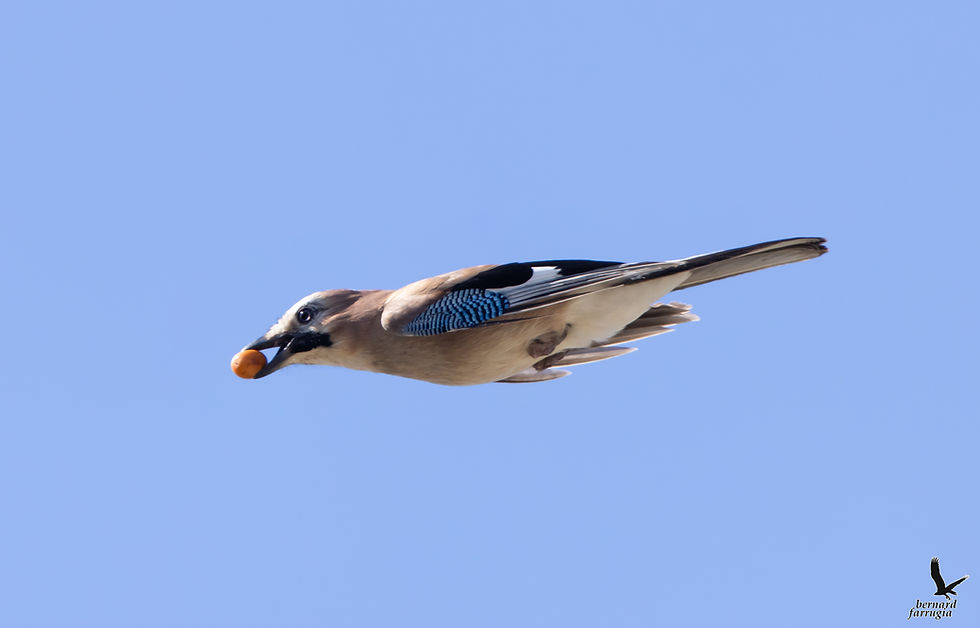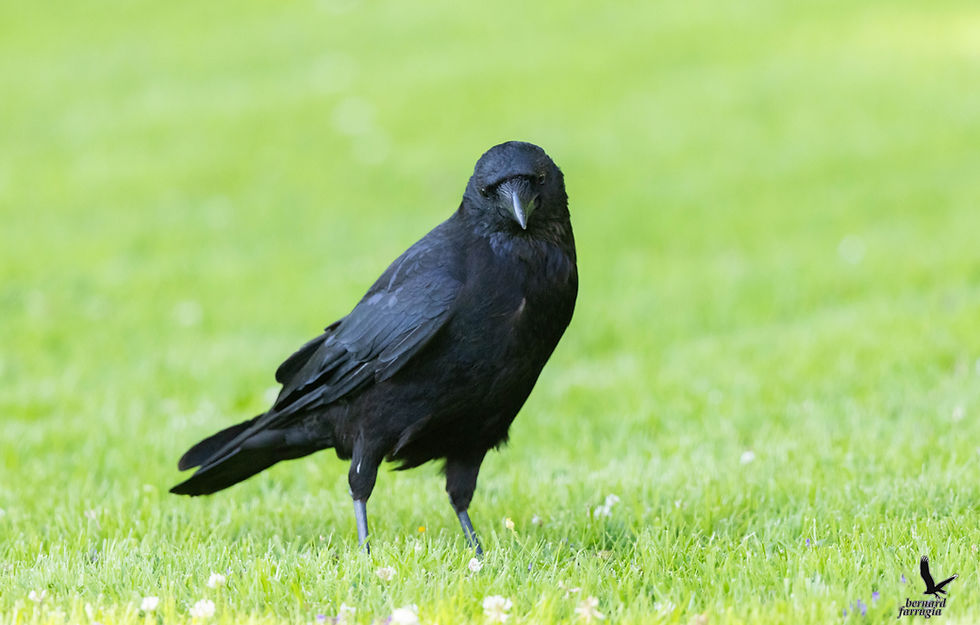top of page

Crows, Jays & Starlings
Red-billed Chough
Red-billed Chough
Maltese name/s
Scientific binomen
Order
Family
Sighting occurrence
Info*
Only one record in 1975.
All black plumage, red legs and long, curved, red bill. Bill of juveniles yellowish-brown and shorter. Though never as pure yellow as in Alpine Chough, and more curved. Easily confused with Alpine Chough at a distance where both species occur, but note broader, more fingered wings, shorter and squarer tail with broader base and different calls. Flight extremely acrobatic.
Diet
Choughs feed in pairs or flocks. A specialist feeder on invertebrates, they will take beetles and their larvae, fly larvae (especially leatherjackets), ants, their grubs and pupae, spiders, sand hoppers, and sometimes earthworms.
Longevity record
17 years 5 months (EC 00074- Found dead in the GB)
Ċawla Munqarha Aħmar
Pyrrhocorax pyrrhocorax
Passeriformes
Corvidae
Vagrant
Usually seen in
-
Occasionally seen in
Only one record in November of 1975
Click on the image to open slideshow

Adult
Red bill indicating an adult bird.

Adult
Red bill indicating an adult bird.
1/1
Length (cm):
Wingspan (cm):
Weight (g):
37 - 41
68 - 80
260 - 350
Pictures taken abroad

Eurasian Jay
Eurasian Jay
Maltese name/s
Scientific binomen
Order
Family
Sighting occurrence
Info*
Largely unmistakable. Pale pinkish brown. Wings dark with white and blue patches. Tail black and rump white (conspicuous in flight). Crown speckled in black. Striking black moustache stripe. Flight pattern straight and fluttering like Nutcracker, but tail longer and bill shorter.
Diet
Feeding in both trees and on the ground, it takes a wide range of invertebrates including many pest insects, acorns (oak seeds, which it buries for use during winter), beech and other seeds, fruits such as blackberries and rowan berries, young birds and eggs, bats, and small rodents.
Longevity record
17 years 0 months (DS 22102 - Found dead in the GB)
Ċawla Dumnikana
Garrulus glandarius
Passeriformes
Corvidae
Vagrant
Usually seen in
-
Occasionally seen in
May, August, October
Click on the image to open slideshow




1/8
Length (cm):
Wingspan (cm):
Weight (g):
32 - 35
54 - 58
140 - 190
Pictures taken abroad

Magpie
Eurasian Magpie
Maltese name/s
Scientific binomen
Order
Family
Sighting occurrence
Info*
Seen individually.
An unmistakable black and white passerine of it's size in Europe. Short rounded wings and exceptionally long tail. Wings fan-shaped and tail graded. Tail constitutes about half of the total length in adult birds. Compact body but relatively long legs. Flat crown. White wing patches/flight feathers very conspicuous in flight.
Diet
Food includes invertebrates and their larvae, seeds, nuts, fruit and carrion. Some young nestlings and fledgling of songbirds are also taken, but this is not a major food source.
Longevity record
21 years 8 months (74564 - Shot in the GB)
Ċawla Dumnikana
Pica pica
Passeriformes
Corvidae
Vagrant
Usually seen in
-
Occasionally seen in
September - November
Click on the image to open slideshow




1/5
Length (cm):
Wingspan (cm):
Weight (g):
40 - 51
52 - 60
175 - 295
Pictures taken abroad

Western Jackdaw
Western Jackdaw
Maltese name/s
Scientific binomen
Order
Family
Sighting occurrence
Info*
Usually seen individually. The one in the pictures was photographed by Bernard Farrugia on the 24th April 2018 in the limits of Siġġiewi.
Small, compact and energetic crow with black upperparts, dark grey underparts and short bill. Most visible plumage character is the pale grey hind neck contrasting with the dark face. Eye white in adults. Often recognized from its compact body and upright posture and gait alone. Flight quick and light.
Diet
Food includes invertebrates and their larvae, seeds, nuts, fruit and carrion. Some young nestlings and fledgling of songbirds are also taken, but this is not a major food source.
Longevity record
20 years 4 months (Denmark)
Usually seen in
-
Occasionally seen in
January, March, April, November
Click on the image to open slideshow

24-04-18

24-04-18

24-04-18
1/2
Length (cm):
Wingspan (cm):
Weight (g):
30 - 35
64 - 73
180 - 270

Rook
Rook
Maltese name/s
Scientific binomen
Order
Family
Sighting occurrence
Info*
An all shiny black crow with diagnostic bare, pale grey base of bill, and "baggy trousers". Juveniles lacks bare bill base and are difficult to separate from Carrion Crow. Young Rooks however, has a steeper forehead and more conical bill with less curved culmen. Tail is more rounded and base of wings more narrow. Flight action includes less gliding than Carrion Crow, and individuals are more spread when a flock flies.
Diet
Rooks will eat almost anything, including worms, grain, nuts and insects, small mammals, birds (especially eggs and nestlings) and carrion.
Longevity record
22 years 11 months (FV 55866, Found dead in GB)
Korvu
Corvus frugilegus
Passeriformes
Corvidae
Vagrant
Usually seen in
April
Occasionally seen in
February, March, May, October - December
Click on the image to open slideshow


1/1
Length (cm):
Wingspan (cm):
Weight (g):
41 - 49
81 - 94
280 - 340

Norther Raven
Northern Raven
Maltese name/s
Scientific binomen
Order
Family
Sighting occurrence
Info*
Buzzard size and largest passerine in the family. All black with very heavy bill, flat crown and shaggy throat. Long, broad wings and wedge-shaped tail. Superb, powerful and often playful flight. Often soars like a raptor.
Diet
They are omnivorous and will feed on everything from small mammals to nesting birds, eggs and berries. They will also eat carrion, scavenge from other predators and even from human landfills. A group, or a flock, of ravens will raid seabird colonies, consuming the eggs and young of these colonies.
Longevity record
23 years 3 months (NOS, Norway)
Għarb
Corvus corax
Passeriformes
Corvidae
Vagrant
Usually seen in
---
Occasionally seen in
---
Click on the image to open slideshow
1/0
Length (cm):
Wingspan (cm):
Weight (g):
54 - 67
115 - 130
800 - 1560

Carrion Crow
Carrion Crow
Maltese name/s
Scientific binomen
Order
Family
Sighting occurrence
Info*
Very similar to Hooded Crow, apart from the all-black plumage. Easily confused with young Rooks, since these lack the naked bill base and baggy trousers of adults. Carrion Crow differs from Rooks by deeper bill with a more curved upper mandible (bill of Rook conical). The wings are evenly broad, not more narrow closer to the body (difficult to judge). Carrion Crow shows no hint of crest, as is often seen in Rooks. Differs from Raven in less deep bill, no neck ruff and rounded, not wedge-shaped, tail.
Diet
They are omnivorous and will feed on everything from carrion, insects, worms, seeds, fruit, eggs and any scraps.
Longevity record
19 years 2 months (Z 58565, Read from the field in Switzerland)
Ċawlun
Corvus corone
Passeriformes
Corvidae
Vagrant
Usually seen in
---
Occasionally seen in
November
Click on the image to open slideshow




1/6
Length (cm):
Wingspan (cm):
Weight (g):
44 - 51
84 - 100
370 - 650
Pictures taken abroad

Hooded Crow
Hooded Crow
Maltese name/s
Scientific binomen
Order
Family
Sighting occurrence
Info*
Usually seen individually. A recent record was photographed by Patrick Spiteri on the 16th March 2019 in the limits of Mellieħa.
Unmistakable, if not in silhouette. In poor light or at a distance, when the grey plumage is not visible, confusion with other crows is possible. Bill is deeper than in Rook, and the upper mandible more curved towards the tip. Smaller than raven, and much less heavy bill. The wings are shorter and more rounded, and the tail is not wedge-shaped. Posture less upright than Rook.
Diet
Hooded crows are omnivores, eating a diet made up of carrion, insects, grain and eggs. They will steal eggs from other birds' nests and are also known to eat chicks on occasion. They can often be seen feeding together in groups.
Longevity record
20 years
Usually seen in
-
Occasionally seen in
March - June, November
Click on the image to open slideshow




1/9
Length (cm):
Wingspan (cm):
Weight (g):
44 - 51
84 - 100
410 - 675
Some pictures taken abroad

Rosy Starling
Rosy Starling
Maltese name/s
Scientific binomen
Order
Family
Sighting occurrence
Info*
Usually seen individually, in small groups and can also be seen with other Common Starlings.
Adults at close range unmistakable with their striking pink and shiny black plumage and crest. In flight note the pale back in contrast to the black head and wings. Head profile quite different from Starling. Bill considerably shorter and slightly down-curved. Forehead flatter and head more rounded when crest is not erect. Immature birds more anonymous, with brownish upperparts, pale belly and darker brown wings with pale fringed coverts and flight feathers. Bill yellowish with darker tip and legs flesh coloured. Very gregarious and immature vagrants usually seeks company with Common Starling. Then easily spotted as a much paler bird. Especially the rump stands out in flight. Common Starling sometimes show pale plumage but can then be identified by bill shape. Forages with less rapid head movements than Common Starling.
Diet
The Rosy Starling feeds primarily on flightless locusts and other grasshoppers. It also takes bugs, ants, beetles, moths and caterpillars. Spiders, woodlice and snails are eaten too. After the breeding season, it consumes fruits (wild and cultivated species), seeds of cereals and nectar from several flowers.
Longevity record
15 years
Usually seen in
-
Occasionally seen in
March - April, July - December
Click on the image to open slideshow
1/0
Length (cm):
Wingspan (cm):
Weight (g):
19 - 22
35 - 40
67 - 88

Common Starling
Common Starling
Maltese name/s
Scientific binomen
Order
Family
Sighting occurrence
Info*
Usually seen in small groups or in larger flocks.
Largely unmistakable where other species of starlings don't occur. Shiny, glossy black/dark-green plumage, speckled with white dots. Yellow bill, and pinkish legs. Juveniles brownish with light throat. As they age, winter plumage breaks through the juvenile feathers, creating large dark patches with white spots. These birds frequently puzzles new birders as they are commonly seen, but often not listed in bird guides. Starlings are easily recognized on the ground by their walking gait. Flight profile also characteristic with short sharp-cornered tail and short pointed wings. May be mistaken for a Waxwing when seen in silhouette.
Diet
Eats mostly insects when available, especially beetles, grasshoppers, flies, and caterpillars, also spiders, snails, earthworms, and other invertebrates. Especially in fall and winter, eats a wide variety of berries, fruits, and seeds.
Longevity record
22 years 11 months (Found dead in Denmark,8552412)
Sturnella
Sturnus vulgaris
Passeriformes
Sturnidae
Fairly common
Usually seen in
September - March
Occasionally seen in
August, April - May
Click on the image to open slideshow




1/11
Length (cm):
Wingspan (cm):
Weight (g):
19 - 22
37 - 42
75 - 90

Spotless starling
Spotless Starling
Maltese name/s
Scientific binomen
Order
Family
Sighting occurrence
Info*
Similar to Starling, and may be difficult to tell apart in winter and immature plumages. Most birds are in breeding plumage from March on, completely lacking spots, and with a purple (not green) sheen. Flight feathers lacks pale fringes, and the overall look is much darker than Starling. Elongated head and throat feathers are slightly longer than in Starling. Winter and immature plumage birds difficult to identify, but has small and spearhead-shaped spots, and darker wings (due to lack of pale fringes). Leg colour generally paler pink, than Starling, but some overlap occurs.
Diet
Eats mostly insects when available, especially beetles, grasshoppers, flies, and caterpillars, also spiders, snails, earthworms, and other invertebrates. Especially in fall and winter, eats a wide variety of berries, fruits, and seeds.
Longevity record
8 years 6 months (Controlled by ringer, 3173460)
Sturnella sewda
Sturnus unicolor
Passeriformes
Sturnidae
Vagrant
Usually seen in
---
Occasionally seen in
March, April
Click on the image to open slideshow



1/2
Length (cm):
Wingspan (cm):
Weight (g):
20 - 23
38 - 42
75 - 96
Pictures taken abroad

*Some information was sourced from ''BirdID Nord University''.
bottom of page
